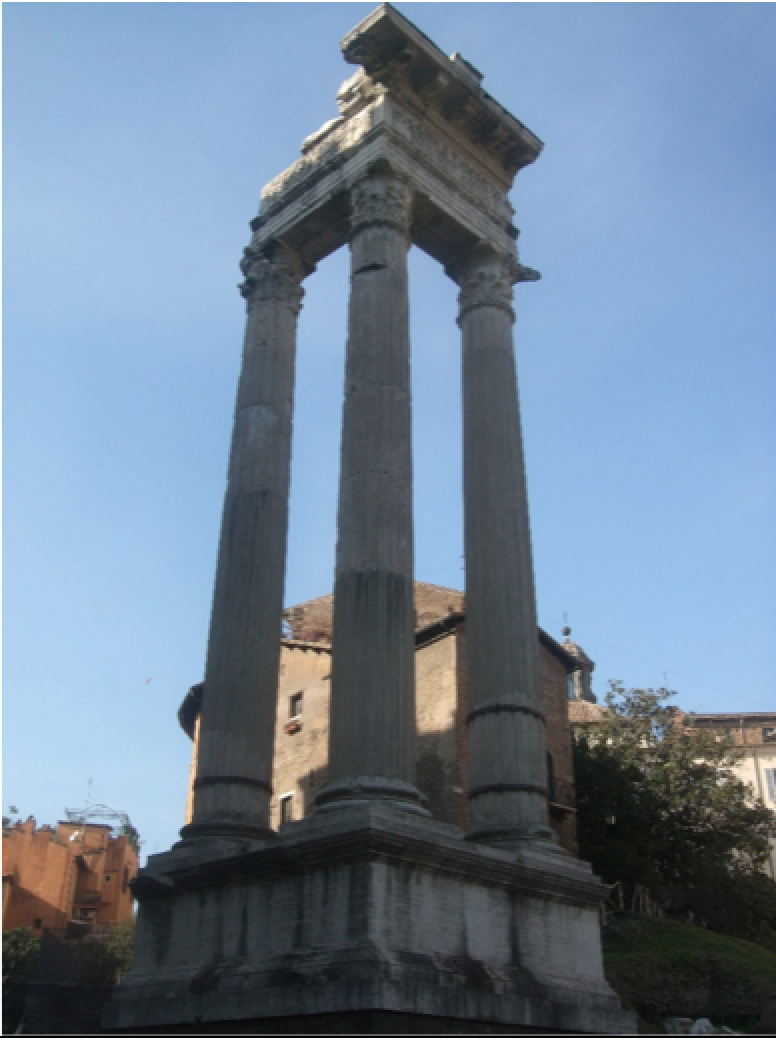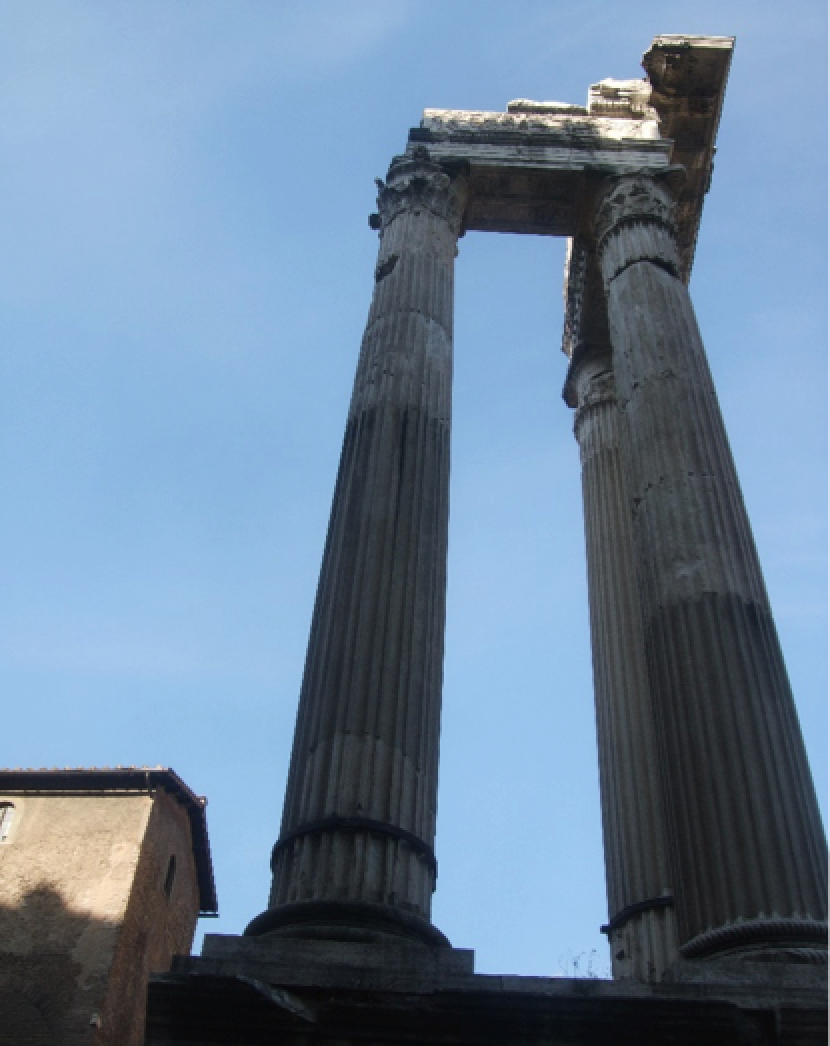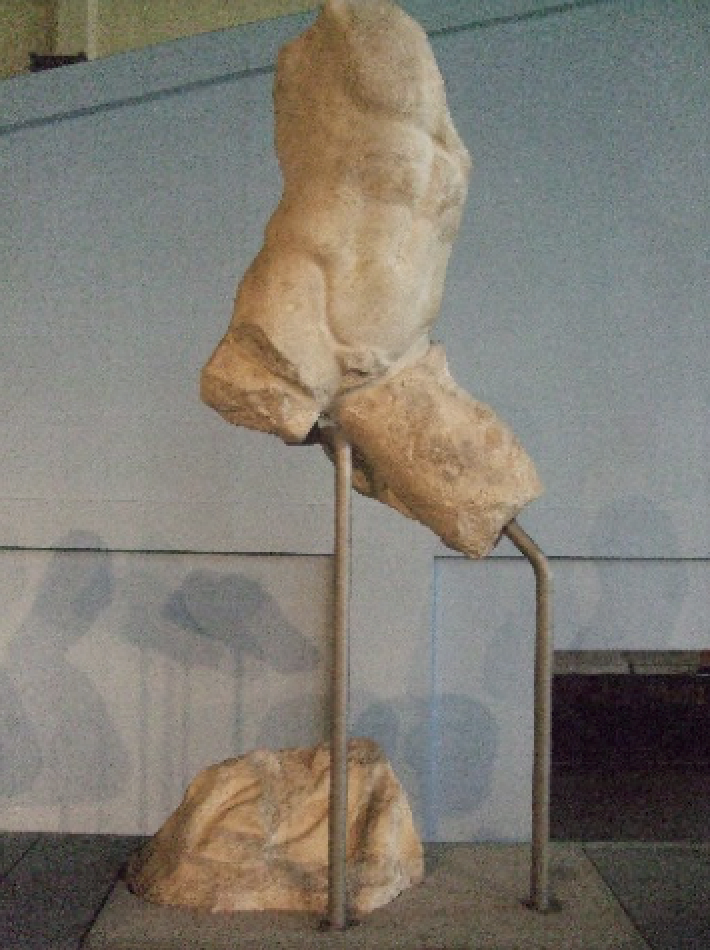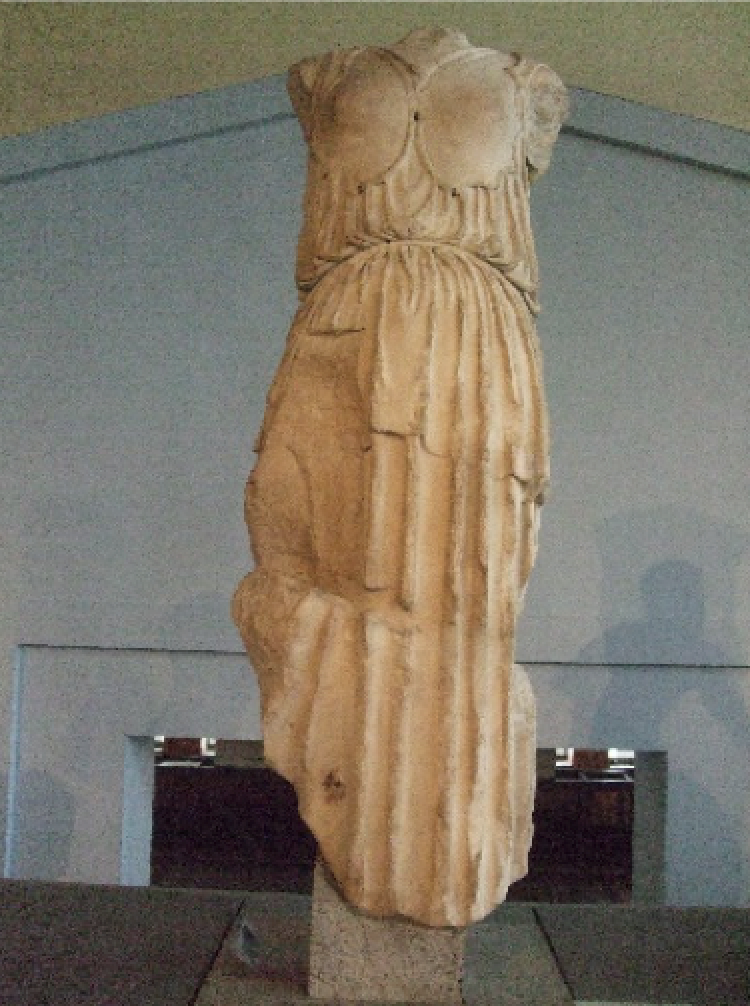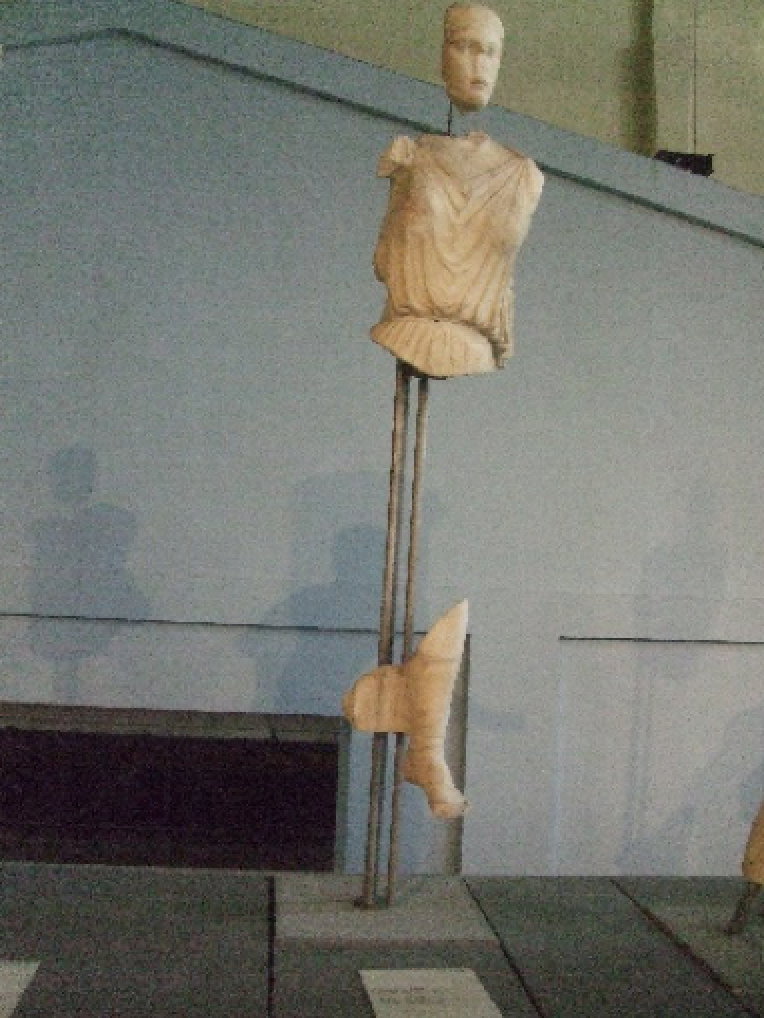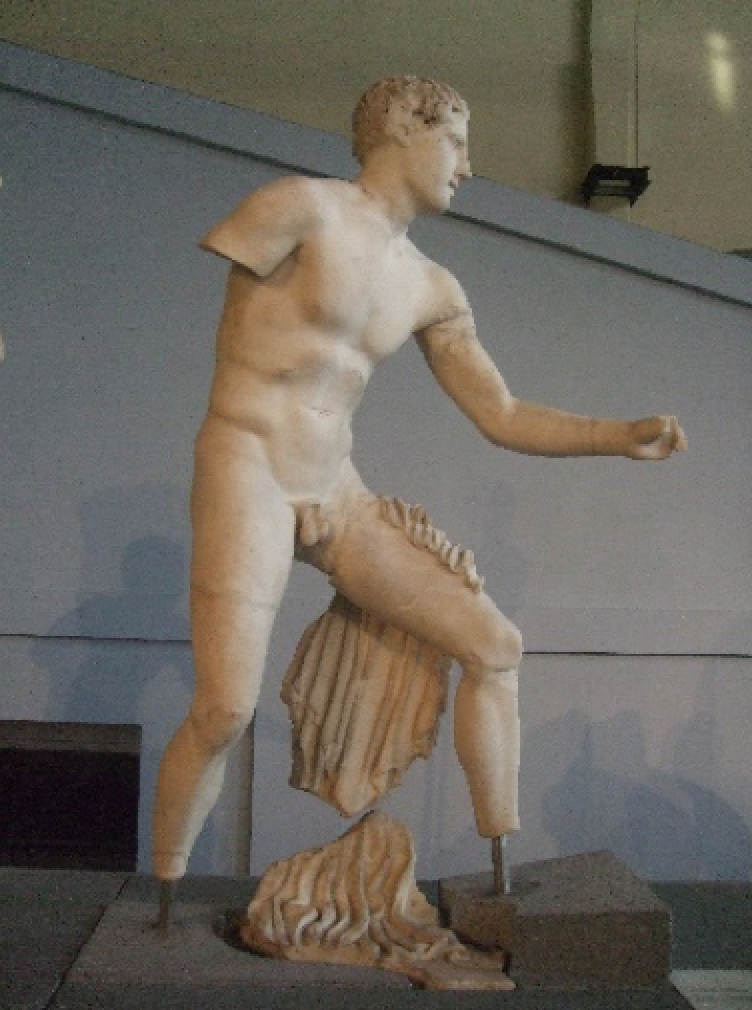This month’s blog by Mark Crittenden, a Kent postgraduate, explores the politics of the Augustan Age and questions whether we should interpret sculpture entirely in light of the politics of the time. More specifically, why does this temple take the cognomen Sosianus and should we read the sculpture in the light of triumviral politics – as opposed to the action of piety in which fifth century sculptures from Greece were used to restore an ancient temple?
The Temple of Apollo was one of the oldest in Rome dating back to the 5th century B.C. and dedicated to Apollo Medicus after a plague that had swept through the city (Livy. 4.25.3).[1] By the time of its restoration the temple under the emperor Augustus, it was somewhat enveloped by the Temple of Bellona, the Porticus of Octavia and the Theatre of Marcellus.
Looking up at the three re-erected columns of the Temple of Apollo Medicus Sosianus between the Portico of Octavia and the Temple of Bellona. Possibly the best view of the pediment, when in place, may have been from the Theatre of Marcelles directly in front of the temple. Photo: Mark Crittenden, Rome.
Standing at the base of the Temple of Apollo Medicus Sosianus, previously known as the Temple of Apollo Medicus, and looking up at the three remaining columns it is difficult to visualise the pediment that once would have stood over the temple’s entrance. The columns were excavated from the other end of the front of the temple in 1926-8 and, so today, are not necessarily in their original location. However, these do provide us with a scale for this building’s height 5.5m to the podium and then 14m for the columns. Thus, the pediment would have stood almost 20 metres above people coming to the temple in antiquity.
 The remnants of the Pediment of Apollo Sosianus on display at the Museo Centrale Montemartini. Photo: Mark Crittenden, Rome.
The remnants of the Pediment of Apollo Sosianus on display at the Museo Centrale Montemartini. Photo: Mark Crittenden, Rome.
Fragments of the pediment were not excavated until 1937-8 and have now been reassembled for display in the Museo Centrale Montemartini. Clearly, these sculptures depict an Amazonamachy – the myth of the war between ancient Greeks and Amazons, which symbolized the fight between the civilised and uncivilised worlds. The pediment sculpture was probably added to the temple during its restoration by Gaius Sosius in the late 1st century B.C. The appearance of the Amazonamachy on the Temple of Apollo Medicus has caused a debate amongst scholars such as Robert Gurval, Jonathan Hall, and Eugenio La Rocca. La Rocca related the sculptures to a restoration in the Augustan period and read the imagery in the context of the politics of the 2nd Triumvirate and the war between Octavian and Anthony. For La Rocca, the pedimental sculpture fits a reading of the Battle of Actium as a fight between the civilised led by Octavian and the uncivilised led by Cleopatra and Anthony.
Robert Gurval views this interpretation as a “complex and confused allusion”; after all who is meant to represent who, as both Antony and, later, Augustus were equated with the hero Hercules, and so the question arises: what role does Theseus play? More importantly, for Gurval, what role does the Greek goddess Athena now play within Roman politics – if this allegory is to be believed? It would appear that La Rocca has over-analysed the sculpture and attempted to make it fit the political situation.
The relevant facts regarding Sosius and Augustus are worth reviewing at this point. Sosius was awarded a triumph for his victory in Judea in 34 B.C. (Tac. 5.9) and held a consulship in 32 B.C. (Dio. 49.41.4), but he appears to have picked the wrong side in the Battle of Actium in 31 B.C. and was defeated (Dio 50.14.1) -thus, a vanquished enemy of Octavian. Cassius Dio also points to the fact that Augustus (formerly Octavian) forgave Sosius (51.2.4). What is fascinating though is that Sosius was restoring the temple of Apollo Medicus at the very time that Augustus was building the new temple of Apollo, next to his own house, on the Palatine – listed in the Res Gestae by Augustus himself
 No. 33, is the location of the Temple of Apollo Medicus, highlighted in yellow, and then the added epithet Sosianus, surrounded by the Temple of Bellona, The Porticus of Octavia and the Theatre of Marcellus. Photo: Screenshot from http://digitalaugustanrome.org/ the image is courtesy of David Gilman Romano, Digital Augustan Rome, http://digitalaugustanrome.org – entry was created by Omur Harmansah.
No. 33, is the location of the Temple of Apollo Medicus, highlighted in yellow, and then the added epithet Sosianus, surrounded by the Temple of Bellona, The Porticus of Octavia and the Theatre of Marcellus. Photo: Screenshot from http://digitalaugustanrome.org/ the image is courtesy of David Gilman Romano, Digital Augustan Rome, http://digitalaugustanrome.org – entry was created by Omur Harmansah.
From top to bottom: Hercules (who would have been standing next to the Amazonian queen), Athena, Nike, and Theseus (thus implying that he was being crowned by Nike). It is this “line up” that La Rocca interprets as Hercules and the Amazonian queen were Antony and Cleopatra on one side whilst the victorious Octavian was Theseus on the opposite. Photo: Mark Crittenden, Rome.
The temptation is, of course, to regard Sosius, the old enemy, competing with Augustus, but perhaps this is to misinterpret the role of both Augustus’ and Sosius’ role as quindecimviri. The quindecimviri were one of the four major colleges of the Roman priesthood and recruited by election from Rome’s noblest families, their main function was to guard the Sibyline books which held the ritual texts. It would have been their duty and responsibility to maintain and restore the temples in order to consult with them during a time of crisis. Both men were simply either carrying out the required restoration work or building a new temple to the same god in a different location. This, in my view, is a more plausible reason for the simultaneous work being employed, rather than the over-interpretation of the imagery linked to political motives. Also, there is no evidence that would indicate that Antony had influenced Sosius in his choice of restoration projects to oppose those of Octavian/Augustus.
The choice of pediment decoration can be found in Pliny the Elder’s Natural History and his descriptions of the works that had been chosen to adorn the inside of the temple. He listed paintings and sculptures from the best artists found in the Greek world such as Aristides of Thebes (35.99), Scopas or Praxiteles (36.28), Philiscus of Rhodes (36.34), and Timarchides (36.35) and the subjects range from the god Apollo himself, the Niobids, and the Muses.[10] The subject matter of the art clearly reflects a passion for Greek sculpture and painting of Greek myth. The date of the pediment sculpture from the 5th century B.C. should also be taken into consideration, which corresponds with the date of the temple’s original construction date (Livy. 25.4.3). It would appear that in his restoration work Sosius was keen to preserve the temple, as one that was ancient and was perhaps an early example of anastylosis (a reconstruction technique whereby a building is restored using the original architectural elements). This is supported by the fact that the pediment of the temple is very much in keeping with the artwork that is on the inside. Thus, we should view all the imagery as a whole collection rather than separately. This allows us to see why Sosius’ name was added to that of the temple – it celebrated his achievements in fulfilling his duties in relation to the restoration of a sacred place of considerable antiquity and preserved ancient sculpture and paintings. In some ways, anticipating the collection of sculptures that Tiberius would display in his restored Temple of Concordia in the Forum Romanum from 7 BC.
Further Reading
Claridge, Amanda. Rome. An Oxford Archaeological Guide. 2nd Edition. Oxford: Oxford University Press, 2010. pp 277 – 279
Coarelli, Filippo. Rome and Environs. An Archaeological Guide. James J. Clauss and Daniel P. Harmon (trans.). Updated Edition. London: University of California Press, Ltd., 2014. pp 270
Gurval, Robert Alan. Actium and Augustus. The Politics and Emotions of Civil War. Ann Arbor: The University of Michigan Press, 1995. pp 116 – 119
Hall, Jonathan M. Artifact and Artifice Classical Archaeology and the Ancient Historian. London: The University of Chicago Press, Ltd., 2014. pp 44 – 48
Stamper, John W. The Architecture of Roman Temples. The Republic to the Middle Empire. Cambridge: Cambridge University Press, 2005. pp 119
